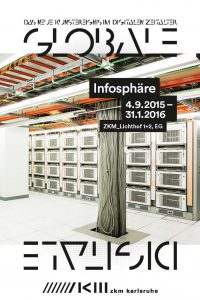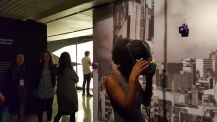Infosphere, ZKM Karlsruhe, Catalogue

GLOBALE: Infosphere
ZKM | Center for Art and MediaExhibition brochure, 65 pages
2015
Deutsch, English
Peter Weibel, Daria Mille, Giulia Bini
http://zkm.de
The »Infosphere« exhibition presents an overview of art in the era of the digital revolution and its social consequences. In addition, it provides insights into the new data world – whose existence has been finally brought home to the general public, through the NSA affair.
Today, people live in a globally interconnected world in which the biosphere and the infosphere are interfused and interdependent. The Earth is surrounded by a layer of gases which we call the atmosphere. It is the product of photosynthesis, of algae working for millions of years, converting light energy from the sun into air. Evolution’s answer to the atmosphere was the lung. Thus the atmosphere is essential for most living organisms, including people. For around 150 years now, we have been surrounded by an infosphere, as well. With this neologism the technical network is meant, consisting of telegraphy, telephony, television, radio, radar, satellites, and the Internet, which covers the globe and enables global exchange of data as well as the organization of transport for people and goods. Without the global traffic in data, goods, and passengers it would be impossible to meet the biological and social needs and aspirations of over seven billion people.
In the nineteenth century, new transport routes and paths of communication were developed through machines operating on land, sea, and in the air. In the years 1886 to 1888, Heinrich Hertz conducted experiments proving the existence of electromagnetic waves and demonstrating that light consists of these electromagnetic waves. With this discovery, the age of wireless communication began, which enabled message and messenger to be separated: Henceforth data could travel through space without the body of a messenger. In the twentieth century, this resulted in a densely interconnected communication and information network of mobile media: the infosphere – an envelope of radio waves surrounding the Earth. Using artificial, technical organs human beings can, for the first time, use electromagnetic waves for the wireless transmission of words, images, and other data – waves for which humans do not actually possess a sensorium. The social media, which have changed our daily lives, are a part of these technological networks. Thus the formula for the nineteenth and twentieth centuries, “Machinery, Material, and Men” (Frank Lloyd Wright, 1930), must be modified for the twenty-first century: “Media, Data, and Men” (Peter Weibel, 2011). Now that the alphabetic code has been supplemented by the numeric code, algorithms constitute a fundamental element of our social order – from stock exchanges to airports. Against this backdrop, contemporary art operating in the thematic field of big data is especially significant.
Curator: Peter Weibel (Curator), Daria Mille (Co-Curator), Giulia Bini (Co-Curator)
Participating artists
Timo Arnall & Jack Schulze & Einar Sneve Martinussen · Amy Balkin · Aram Bartholl · Wafaa Bilal · Zach Blas · Blast Theory · Bonjour, interactive lab (Jean-Philippe Jacquot, Gustave Bernier & Alexandre Rivaux) · Natalie Bookchin · Dineo Seshee Bopape · David Bowen · James Bridle · Bureau d’Études · Emma Charles · Tyler Coburn · Sterling Crispin · Stéphane Degoutin and Gwenola Wagon · Dennis Del Favero with Elwira Titan, Peter Weibel · Aleksandra Domanović · Thomas Feuerstein · Fraunhofer-Institut für Optronik, Systemtechnik und Bildauswertung IOSB · Laurent Grasso · Yoon Chung Han & Byeong-Jun Han · Jonathan Harris · Mishka Henner · Femke Herregraven · Brian House · Scottie Chih-Chieh Huang · Jennifer Lyn Morone™ Inc · Jia · JODI · Matt Kenyon (SWAMP) · Erik Kessels · Jeong Han Kim, Hyun Jean Lee, Jung-Do Kim · Brian Knappenberger · Oliver Laric · Marc Lee in cooperation with the Chair for Intelligent Sensor-Actuator-Systems (ISAS), ZAK | Centre for Cultural and General Studies at Karlsruhe Institute of Technology (KIT) · George Legrady · Rafael Lozano-Hemmer ·!Mediengruppe Bitnik · Laurent Mignonneau & Christa Sommerer · Jonathan Minard & James George · Warren Neidich · The Office for Creative Research (Mark Hansen, Ben Rubin, Jer Thorp) · The Otolith Group · Julius Popp · Jon Rafman · REMOTEWORDS (Achim Mohné / Uta Kopp) · Stephanie Rothenberg · RYBN.ORG · Mario Santamaria · Philipp Schaerer · Semiconductor · Shinseungback & Kimyonghun · Adam Slowik · Smart Citizen Team in cooperation with IAAC | Fab Lab Barcelona, Media Interactive Design and Hangar · Karolina Sobecka, Christopher Baker · Werner Sobek, Stuttgart · Software Studies Initiative (Lev Manovich, Nadav Hochman, Jay Chow, Damon Crockett) · Superflux · Fabrizio Tamburini · Timo Toots · Suzanne Treister · Unknown Fields Division · Clement Valla · Alex Verhaest · Richard Vijgen · Christoph Wachter & Mathias Jud · Addie Wagenknecht · Gwenola Wagon · Where dogs run · Krissy Wilson · Manfred Wolff-Plottegg mit Peter Weibel und Verena Noack · Matthias Wölfel / Angelo Stitz / Tim Schlippe · Erweiterte Sinnesorgane
Exhibited Artwork
10.000 Moving Cities - Same but Different, VR (Virtual Reality)
Interactive Net- and Telepresence-Based Installation
FILE, São Paulo

Interface

Screenshot